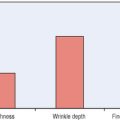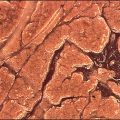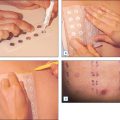Chapter 22 Wrinkles and Fine Lines
This chapter deals with those ingredients that are marketed for the purpose of improving the appearance of fine lines and wrinkles. The ingredients have been divided into several categories based on function: botanical antioxidants, vitamin antioxidants, and cellular regulators (Tables 22.1, 22.2, 22.3). These ingredients represent the most popular cosmeceuticals placed in moisturizers designed to minimize fine lines and wrinkles. It is important to remember that the effects of the moisturizing ingredients cannot be separated from those of the cosmeceutical active in most cases. Nevertheless, moisturizers are the most common cosmeceutical wrinkle treatment currently available.
Table 22.1 Botanical antioxidants
| Cosmeceutical | Effects on skin physiology | Patient selection comments |
| Soy | Flavonoid antioxidant with estrogenic effect, genistein and daidzein | Improves skin thickness |
| Curcumin | Polyphenol antioxidant with tetrahydrocurcumin, used as a natural preservative | Slight burning sensation possible on application |
| Green tea | Polyphenol antioxidant with epigallocatechin | Must be used freshly brewed or stabilized with BHT as oxidizes to brown color rapidly, useful as a photoprotectant |
| Silymarin | Flavonoid antioxidant with silybin, silydianin, and silychristine | May be useful topically in photosensitive individuals |
| Pyncogenol | Phenol and phenolic acid antioxidant | Useful in supplementing antioxidant effects of vitamins C and E |
| Lutein and lycopene | Carotenoid antioxidant | Best consumed orally in fresh picked ripe tomatoes |
| Rosmarinic acid | Polyphenol antioxidant | Found in high concentration in fresh rosemary leaves |
| Hypericin (St John’s wort) | Polyphenol antioxidant | Must not be consumed orally in large quantities |
| Ellagic acid (pomegranate fruit) | Polyphenol antioxidant | Marketed as potent antioxidant for topical and oral use |
Table 22.2 Vitamin antioxidants
| Cosmeceutical | Effects on skin physiology | Patient selection comments |
| Vitamin E | Alpha tocopherol active primary skin antioxidant form | Primary substance responsible for the prevention of oxidation of cell wall lipids, poor topical penetration |
| Vitamin C | L-ascorbic acid, secondary skin antioxidant form peroxidation | Regenerates vitamin E to active form to prevent cell membrane lipid, poor topical penetration beyond epidermis |
| Niacinamide | Decreases protein glycation to function | Nonirritating exfoliant |
| Alpha-lipoic acid | Antioxidant | Synthesized by body in mitochondria, not a true vitamin |
| Ubiquinone | Antioxidant | Synthesized by body, not a true vitamin, regenerates vitamin E |
| Idebenone | Antioxidant | Newer form of ubiquinone with stronger cutaneous antioxidant effects |
| Retinol | Vitamin A | May be irritating at high concentration above 1%, must be stabilized for activity |
| Retinyl propionate | Vitamin A ester | Less irritating than other topical retinoids |
| Retinyl palmitate | Storage form of vitamin A | Weak biologic activity, sometimes used as product antioxidant preservative |
Table 22.3 Cellular regulators
| Cosmeceutical | Effect on skin physiology | Patient selection comments |
| Fibroblast growth factors | Fibroblast spent culture media containing numerous unknown fibroblast secreted substances, such as epidermal growth factor, transforming growth factor-beta, and platelet-derived growth factor | Unusual smell imparted to moisturizer product, does not appear to promote growth of other skin lesions |
| Signal peptides | Pentapeptide Pal-KTTKS, collagen I fragment that downregulates collagenase production | Used in 4–6 ppm in moisturizers, clinical data lacking |
| Neurotransmitter peptides | Hexapeptide argireline, inhibits neurotransmitter release to decrease muscle movement and wrinkles | Attempts to mimic effect of botulinum toxin on muscles, clinical data lacking |
The larger question is whether wrinkles and fine lines can be reduced through more permanent mechanisms, since neither moisturization nor exfoliation benefits are long lasting. The best method of wrinkle reduction is restoration of lost collagen and elastic fibers that account for thinning skin. There is some extrapolation that cosmeceutical retinoids, such as retinol, retinyl propionate, and retinyl palmitate, may have some of the collagen regeneration benefits of prescription tretinoin. Yet, these benefits cannot be discussed fully in a cosmetic arena. Other methods of wrinkle reduction include restoration of the underlying bone and subcutaneous fat that support the skin. Some of the most concerning folds of the aging face are not from moisturization defects or collagen loss, but rather due to skin that drapes over a shrinking suboptimal framework. Unfortunately, cosmeceuticals can do nothing for this type of facial fold.





